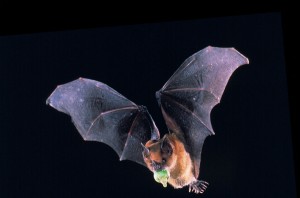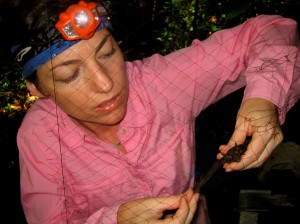Tropical Forests Depend on Bats for Survival
Posted in Science, Shop/Book Reviews on June 2 2009, by Plant Talk
New Book by Garden Scientists Identifies Role in Seed Dispersal
 |
Scott A. Mori, Ph.D., Nathaniel Lord Britton Curator of Botany, specializes in the classification, ecology, and evolution of the Brazil nut family and is especially interested in plant/animal interactions in tropical forests, including the pollination and dispersal of seeds by bats, the subject of his new book recently released by NYBG Press. Scott co-authored Seed Dispersal by Bats in the Neotropics with Botanical Garden post-doctoral fellow Tatyana Lobova, Ph.D. (now an Assistant Professor of Biology at Old Dominion University and an Honorary Curator of the Institute of Systematic Botany of NYBG) and student Cullen Geiselman (doctoral candidate in the joint program of the Department of Ecology, Evolution, and Environmental Biology of Columbia University and the Institute of Systematic Botany of NYBG). |

One of my roles as a scientist at The New York Botanical Garden is to inform policy makers and the general public about the ways in which plants depend upon animals for their survival, because conservation programs that fail to take the co-evolutionary relationships between plants and animals into account are doomed to failure. That, in part, was the purpose for writing Seed Dispersal by Bats in the Neotropics, in which my co-authors and I demonstrate the vital role bats play in maintaining the diversity of plants in New World tropical forests.
Bats are especially important as pollinators of flowers and dispersers of seeds, and this has become increasingly apparent as more and more bat/plant studies are published. In the book we review the role bats play as seed dispersers for the first time since A.L. Gardner’s classic paper on the topic in 1977. We present a literature review of all plants known to be dispersed by bats and all species of bats known to disperse seeds. We also present a summary of our intensive field studies of bat seed dispersal in central French Guiana. Our sampling expeditions took us to disturbed rain forest habitats as well as to some of the most pristine rain forests in the world.

For over five years, we reviewed the literature on Neotropical bat/plant interactions and carried out field trips to French Guiana. Our basic research technique was to capture bats in the same kind of mist nets normally used to catch birds (see photo), hold the bats in numbered cloth bags until they defecated, and then identify the seeds found in the bags by comparing them to seeds represented in herbarium collections. We would look at the specimens of plants we had collected on the same expeditions that we were netting bats (we netted bats at night and collected plants during the day) and would also use the descriptions and images of seeds we found in the reviewed literature to help us identify the seeds we found in the bats’ feces. Our book includes 32 color plates of seeds that we demonstrated to be dispersed by bats, and this will be useful to help other researchers identify fruits and seeds regardless of where in the Neotropics they are carrying out their studies.


